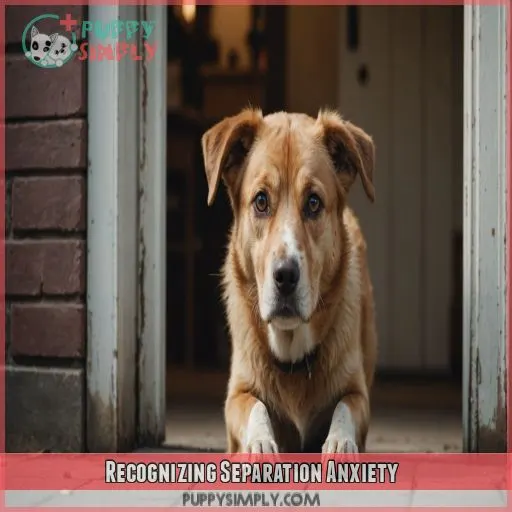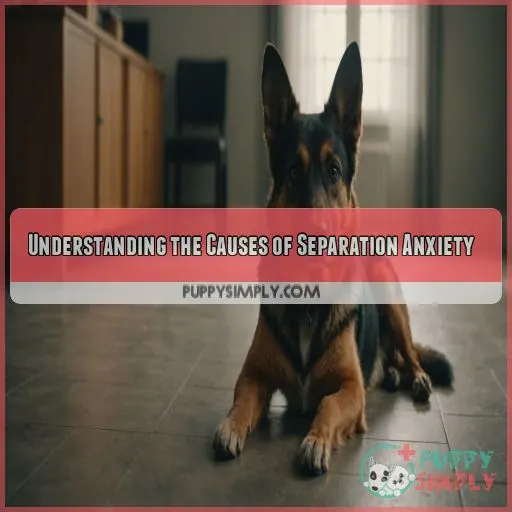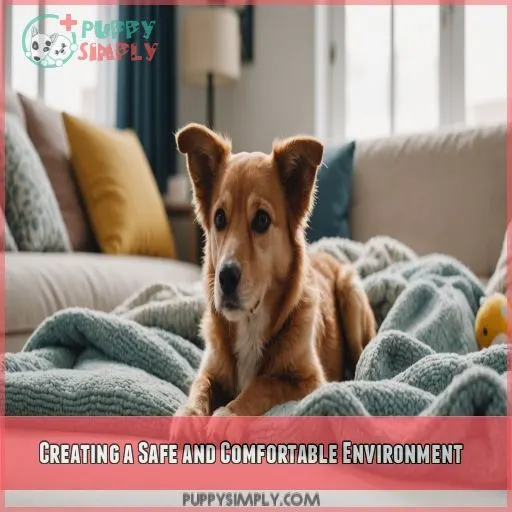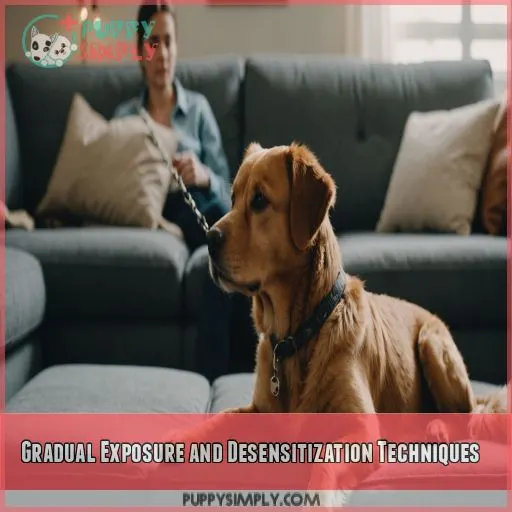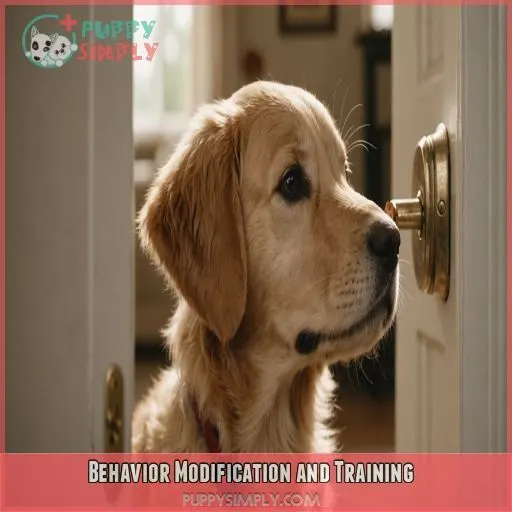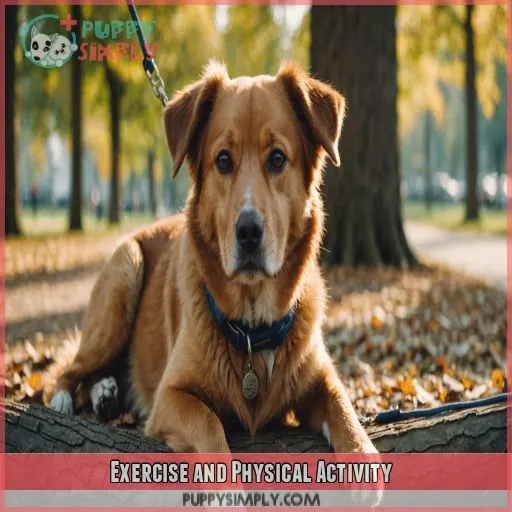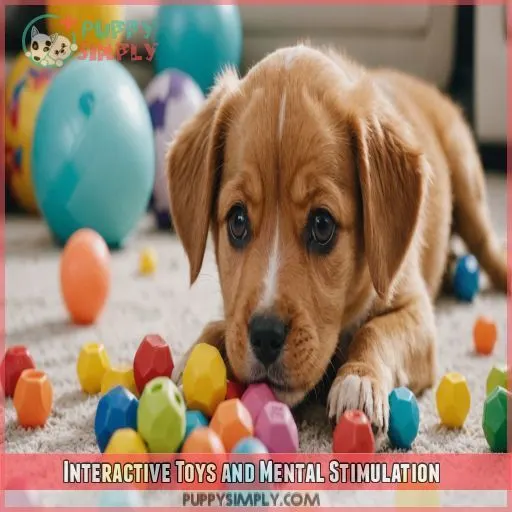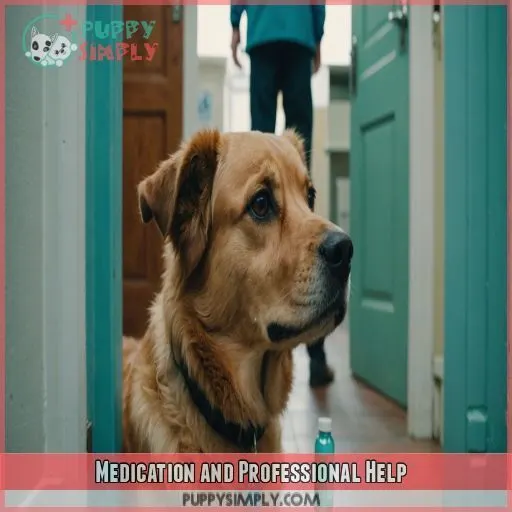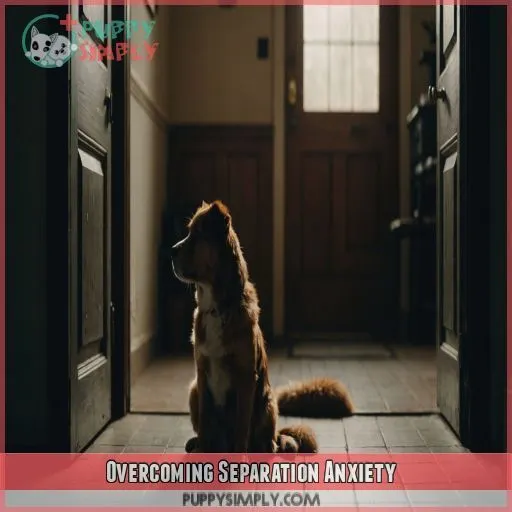This site is supported by our readers. We may earn a commission, at no cost to you, if you purchase through links.
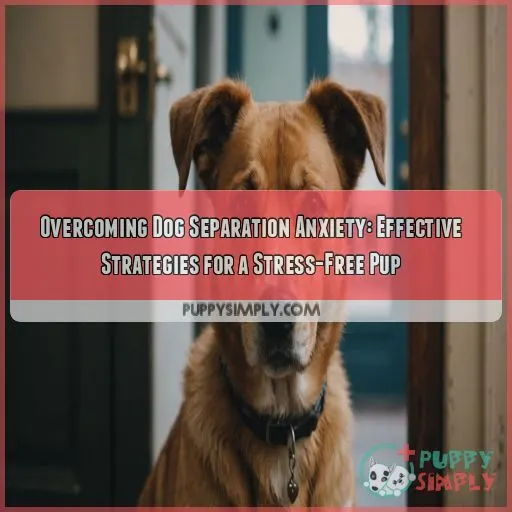 You’re worried about your furry friend’s separation anxiety? Don’t worry, you’re not alone!
You’re worried about your furry friend’s separation anxiety? Don’t worry, you’re not alone!
Overcoming dog separation anxiety requires a combination of understanding the causes, creating a safe environment, and using positive reinforcement techniques.
Start by recognizing the signs and symptoms, and distinguishing between separation anxiety and other issues.
Then, design a calming space, provide mental stimulation, and reduce stress triggers.
Gradually expose your dog to short absences and gradually increase the time and distance.
Reward calm behavior, and teach relaxation techniques.
With patience and consistency, you can help your dog overcome separation anxiety and regain a sense of calm and confidence.
But for now, take a deep breath and know that you’re on the right path – for more practical tips and expert advice, read on!
Table Of Contents
- Key Takeaways
- Recognizing Separation Anxiety
- Understanding the Causes of Separation Anxiety
- Creating a Safe and Comfortable Environment
- Gradual Exposure and Desensitization Techniques
- Behavior Modification and Training
- Exercise and Physical Activity
- Interactive Toys and Mental Stimulation
- Medication and Professional Help
- Understanding the Role of Medication in Separation Anxiety
- Consulting With a Veterinarian or Behaviorist
- Exploring Alternative Therapies and Supplements
- Creating a Comprehensive Treatment Plan
- Minimizing Disturbances and Reducing Anxiety
- Creating a Low-Key Departure Routine
- Ignoring Your Dog Upon Return
- Rewarding Calm Behavior
- Overcoming Separation Anxiety
- Frequently Asked Questions (FAQs)
- How to break separation anxiety in dogs?
- Can separation anxiety in dogs be cured?
- How do I stop my dog from crying when I leave?
- How to cope with being away from your dog?
- Can I leave my dog alone for a weekend?
- How long does it take to overcome separation anxiety?
- Can separation anxiety be triggered by a new pet?
- Will my dog ever be able to stay alone?
- Can I use positive reinforcement with an older dog?
- Conclusion
Key Takeaways
- You’re not alone in this struggle – separation anxiety is super common, and with patience and practice, you can help your furry friend feel more calm when you’re away.
- Don’t underestimate the power of small steps – gradual exposure to being alone, low-key departures, and rewarding calm behavior can make all the difference in reducing your dog’s separation anxiety.
- Create a calming environment that’ll make your dog go "ahh" – use soothing music, white noise, or aromatherapy to create a relaxing atmosphere, and consider adding a cozy, quiet space where they can retreat when they’re feeling anxious.
- You don’t have to be a pro – work with a certified trainer or behaviorist to create a customized plan that addresses your dog’s unique needs, and don’t be afraid to ask for help along the way – you and your pup are worth it!
Recognizing Separation Anxiety
Is your furry friend acting out whenever you head out the door? Don’t worry, it’s a common issue called separation anxiety that many dog owners face. Understanding the signs can help you address the root cause and get your pup back to their happy, relaxed self.
Common Signs and Symptoms
Is your pup panting, pacing, or howling when you head out the door? Don’t worry, these are common signs of separation anxiety. Your furry friend may also chew on furniture, have potty accidents, or refuse to eat. The good news is, with the right tactics, you can help ease their stress and keep your home intact.
Distinguishing Between Separation Anxiety and Other Issues
It can be tricky to distinguish separation anxiety from other issues like boredom, medical problems, or even attention-seeking behavior. Look out for signs like destructiveness, excessive vocalizations, and restlessness when you’re gone. If your pup exhibits these consistently, it’s likely separation anxiety at play. Don’t worry, we’ll help you get to the root of the problem!
Assessing the Severity of Separation Anxiety
Figuring out how bad your pup’s separation anxiety is really important. Watch for signs like barking too much, destroying things, and looking really stressed out. How long these episodes last and how often they happen can tell you how serious the problem is. Don’t worry – with the right help, your anxious pup can get better and live a stress-free life.
- Keep track of how intense, long, and frequent the symptoms are.
- Notice any patterns or things that seem to make your dog’s anxiety worse.
- Take your dog to the vet to rule out any health problems.
Understanding the Impact on Dog and Owner
Separation anxiety can take a major toll on both you and your pup. Your dog’s distress when left alone can lead to heartbreaking destructive behaviors, while the constant worry and frustration can strain your bond. But with patience and the right strategies, you can restore that sense of trust and control for a stress-free life together.
Understanding the Causes of Separation Anxiety
Separation anxiety in dogs can have a variety of causes, from major life changes to genetic predisposition. Understanding the root of your pup’s anxiety is the first step in overcoming this challenging issue and restoring a stress-free home.
Changes in Environment and Routine
Your dog’s environment and routine really matter when it comes to separation anxiety. Changes like moving homes, adding a new pet, traveling, or even adopting new schedules can trigger anxious behavior. Gradually desensitize your pup to these changes through:
- Slow introductions to new environments
- Maintaining consistent daily routines
- Providing comforting, familiar items
- Preemptively practicing short departures
Genetic Predisposition and Breed-Specific Traits
Certain dog breeds may be more prone to separation anxiety due to genetic predisposition. If your pup is from an anxious breed, don’t worry – with the right training and care, you can help them overcome their natural tendencies. Stay patient and positive, and work closely with a trainer to address the root causes.
Lack of Socialization and Training
If your pup didn’t get enough socialization and training early on, they may be more prone to separation anxiety. Puppy classes and positive reinforcement training can go a long way in building their confidence and resilience when you need to step away. With a little work, your canine companion can overcome their fears.
Creating a Safe and Comfortable Environment
Creating a safe and comfortable environment is really important for helping your dog overcome separation anxiety. By avoiding punishment and focusing on positive reinforcement, you can build trust and reduce your pup’s stress when you’re away.
Avoiding Punishment and Positive Reinforcement
Punishment only worsens your dog’s anxiety and damages your bond. Instead, focus on positive reinforcement to build trust and address the root cause of their separation distress. Reward calm behavior with treats, praise, or a favorite toy when you return. This gentle approach helps your pup feel safe and understood.
Providing Mental Stimulation and Exercise
In addition to creating a tranquil environment, boosting your pup’s mental stimulation and physical activity can work wonders for overcoming separation anxiety. Engage their curious mind with interactive toys, puzzle games, and training exercises that challenge and reward them. A well-exercised dog is a calmer, more content pup when you’re away.
Designing a Calming Space for Your Dog
Creating a comfortable, cozy retreat can go a long way in soothing your anxious pup. Choose calming colors like blues and greens, provide soft, plush bedding, and consider adding soothing scents like lavender. Minimize noise from TVs or radios, and give your dog their own safe haven during those difficult alone times.
Reducing Stress and Anxiety Triggers
Creating a calming, low-stress environment for your pup is key when tackling separation anxiety.
Identify and minimize potential triggers like loud noises, bright lights, and sudden changes to their daily routine.
Provide a cozy, quiet space where they can retreat – their own personal "safe haven" when you’re away.
Soothing scents, soft bedding, and familiar toys can also help ease their anxiety.
Gradual Exposure and Desensitization Techniques
Overcoming your dog’s separation anxiety takes patience and a step-by-step approach. Start with short absences and gradually increase the time you’re away, all while using positive reinforcement to reassure your furry friend.
Starting With Small Steps and Short Absences
Start small by gradually exposing your pup to short absences, using fake departures and positive reinforcement. Desensitize them to cues like grabbing your keys or putting on shoes. This builds confidence and helps them stay calm when you step out. Take it slow – your dog will thank you for your patience!
Gradually Increasing Time and Distance
Gradually increase the time you leave your pup alone, starting with short 5-10 minute sessions. Slowly build up to longer absences, always returning before they become distressed. This gradual exposure helps desensitize them to departure cues, allowing them to stay calm. Consistency is key – stick to a predictable routine for best results.
Using Positive Reinforcement and Rewards
Positive reinforcement is the secret to success when gradually exposing your pup to being alone. Reward their calm, relaxed behavior with tasty treats and lots of praise. This teaches them that being independent is a good thing, not something to fear. With patience and consistent training, you’ll have a confident, stress-free dog.
Desensitizing Your Dog to Departure Cues
Desensitizing your dog to departure cues is key. Start small – jingle your keys or put on your shoes without actually leaving. Reward your pup with treats and praise for staying calm. Gradually increase the time and build positive associations. This helps them learn that those triggers don’t always mean you’re abandoning them.
Behavior Modification and Training
Helping your dog overcome separation anxiety involves more than just leaving them alone. You’ll need to teach calming behaviors, build their confidence, and manage your comings and goings to create a stress-free environment.
Teaching Calming Behaviors and Relaxation Techniques
Teach your anxious pup calming exercises like deep breathing and progressive muscle relaxation. These relaxation techniques can help them stay calm when you’re away. Reward any relaxed behaviors with treats and praise to reinforce the desired response. Consistent practice will help your dog learn to self-soothe during stressful situations.
Increasing Independence and Confidence
Building your dog’s confidence and independence is really important for overcoming separation anxiety. Try these tips:
- Encourage solo playtime – give them chew toys or food puzzles to enjoy alone.
- Practice crate training to help them feel secure in their own space.
- Enroll in a doggy daycare or hire a dog walker to help them feel comfortable being apart from you.
Managing Departures and Arrivals
Make your comings and goings low-key to avoid triggering your dog’s anxiety. Establish a calming pre-departure routine, like giving them a treat or puzzle toy. When you return, ignore them for the first few minutes before greeting them calmly. Reward your pup for staying relaxed and avoid anything that might spike their stress.
Exercise and Physical Activity
Exercise is a powerful tool in overcoming your dog’s separation anxiety. By tiring them out before you leave, you can help reduce their anxiety and promote a more relaxed state while you’re away.
Reducing Anxiety and Stress Through Exercise
Regular exercise can work wonders for reducing your dog’s separation anxiety. A good workout before you leave helps them burn off excess energy and feel more relaxed while you’re gone. Take your pup for a brisk walk, play fetch, or try an interactive game – just make sure they’re nice and tuckered out before you head out the door.
Increasing Physical Activity and Mental Stimulation
Keeping your pup physically and mentally active is a game-changer for managing separation anxiety.
Try puzzle toys, dog sports, or switching up your walk routes to provide cognitive challenges.
Schedule regular play dates or teach them new tricks for an added mental workout.
Stay one step ahead of boredom – your happy, tired pup will be less anxious when you leave.
Creating a Pre-Departure Routine
Creating a calming pre-departure routine can go a long way in easing your dog’s separation anxiety. Start by introducing subtle cues like picking up your keys or putting on your shoes, rewarding your pup with treats when they remain relaxed. This helps them associate those leaving signals with something positive rather than panic.
Tire Them Out Before Leaving
Tiring out your dog before leaving is key. A long walk, 30-45 minutes, can help them settle down when you’re gone. Consider a light meal or a session of vigorous play like fetch to further burn off that pent-up energy. With their body relaxed, your dog is less likely to become anxious during your absence.
Interactive Toys and Mental Stimulation
Keeping your dog entertained and mentally stimulated while you’re away can go a long way in reducing separation anxiety. Consider leaving your pup with long-lasting chews, interactive puzzle toys, and other engaging activities to keep them busy and happy until you return.
Providing Long-Lasting Chews and Puzzle Toys
Provide long-lasting chew toys and puzzle feeders to keep your pup mentally stimulated while you’re away. Look for sturdy, safe options that will challenge their problem-solving skills and satisfy their natural chewing instincts. These "boredom busters" can help ease separation anxiety and make you a stress-free return.
Engaging Your Dog’s Mind and Reducing Boredom
When your dog is left alone, interactive toys and puzzle games can be game-changers. These "boredom busters" engage their curious minds and satisfy their natural foraging instincts. Try rotating different treat-filled toys to prevent monotony and keep them mentally stimulated. With the right enrichment, your pup will be less likely to get stressed and destructive.
- Puzzle feeders
- Chew toys that dispense treats
- Food-stuffed Kongs
Creating a Calming and Relaxing Environment
Creating a calming, relaxing environment is key for dogs with separation anxiety. Try using white noise, calming music, or aromatherapy to soothe your pup while you’re away. Establish a relaxing pre-departure routine to help them associate your absence with positive experiences. Providing a safe, comfortable space can also ease their worries until you return.
Medication and Professional Help
If your dog’s separation anxiety is severe, you may need to think about medication and professional help to address the issue. By talking to a veterinarian or behaviorist and exploring alternative therapies and supplements, you can create a solid treatment plan that minimizes disturbances and reduces anxiety .
Understanding the Role of Medication in Separation Anxiety
Medication can be a game-changer for dogs with severe separation anxiety. Types of medication include antidepressants, anti-anxiety medications, and sedatives (Source). While effective, medication isn’t a quick fix and should be used in conjunction with training and behavioral modifications (Source). Side effects and costs vary, so you really need to work closely with your vet to find the right medication for your furry friend .
Consulting With a Veterinarian or Behaviorist
Time to bring in the pros! Consulting a veterinarian or behaviorist is really important for tackling separation anxiety. They’ll help you create a customized treatment plan, addressing your dog’s unique needs. Don’t hesitate to seek expert advice – your vet or behaviorist will be your partner in helping your furry friend find peace when you’re away.
Exploring Alternative Therapies and Supplements
Now that you’re consulting with a veterinarian or behaviorist, it’s time to explore alternative therapies and supplements to help your furry friend. Consider these three options:
- Herbal remedies: Calming herbs like chamomile and valerian root can soothe your dog’s anxiety.
- Aromatherapy: Certain scents, such as lavender and vanilla, can promote relaxation.
- Nutritional supplements: Omega-3 fatty acids and CBD oil may help reduce anxiety symptoms.
Creating a Comprehensive Treatment Plan
You’re ready to tackle your pup’s separation anxiety head-on. With a solid treatment plan, you’ll combine medication options, owner involvement, and professional guidance to achieve long-term goals. A certified trainer or behaviorist will help you create a customized protocol, addressing your dog’s unique needs and your lifestyle (Source) . Together, you’ll empower your furry friend to overcome anxiety and thrive.
Minimizing Disturbances and Reducing Anxiety
When you’re figuring out the best way to help your dog, it’s super important to minimize things that might make them anxious.
Think of it like creating a peaceful retreat for them – use white noise or calming music to block out stressors, set up a quiet space as their safe haven, and limit exposure to things that trigger their anxiety.
This will help your furry friend feel more secure and calm when you’re away.
Creating a Low-Key Departure Routine
Let’s create a low-key departure routine to ease your pup’s separation anxiety. Aim for calm cues by avoiding fuss and drama when you leave. Here are four tips to get you started:
1. Practice routine: Stick to a regular daily schedule to reduce anxiety triggers.
2. Avoid fuss: Say goodbye calmly, without making a big deal.
3. Use calm cues: Leave a familiar article of clothing with your scent to provide comfort.
4. Establish a positive association: Reward your dog’s calm behavior upon your return to build trust and confidence.
Ignoring Your Dog Upon Return
When you return home, ignore your dog for a few minutes. I know, it’s tough! But this helps break the anxiety cycle. Your dog will learn that your return isn’t a big deal, reducing their stress. By ignoring them initially, you’re not reinforcing their anxious behavior, allowing them to calm down and rebuilding a healthier bond. Ignoring your dog upon return might feel counterintuitive, but it’s a powerful tool to reduce separation anxiety. By not making a fuss, you’re taking away the attention reward for anxious behavior. This helps break the cycle of anxiety triggers and teaches your dog to associate calm behavior with your return, strengthening your bond and promoting a stress-free reunion. When you return home, ignore your dog initially. I know, it’s tough! But excited greetings can reignite anxiety. By calmly ignoring them at first, you help your dog understand that your return isn’t a big deal. This reduces anxiety triggers and strengthens your bond in the long run. Your dog will learn to associate your return with calm behavior. Here’s the output:
When you return home, avoid making a big fuss over your dog. It’s not because you don’t care; it’s because you’re training them to be calm in your absence. Ignore your dog for the first few minutes after returning home, and let them calm down before interacting with them. This will help them learn to relax without your presence. Later, reward their calm behavior with treats and praise to reinforce the new behavior.
Rewarding Calm Behavior
As you return home, ignore your dog for the first few minutes to give them a chance to calm down. Then, reward them with treats and praise when they exhibit calm behavior. Consistency is key, so use the same calming cues and treat dispensing every time. With positive reinforcement, your dog will learn to associate your departures with calmness.
Overcoming Separation Anxiety
You’ve taken the first step to overcoming your dog’s separation anxiety, and now it’s time to tackle the challenges head-on. With the right strategies and a bit of patience, you can help your furry friend feel calm and secure when you’re not around.
Celebrating Small Successes and Progress
You’re making progress! Celebrate small wins, like a calm departure or a quiet hour alone. These milestones show you’re on the right track. Reward your dog with treats, praise, or playtime. Acknowledge your own efforts too – overcoming separation anxiety takes time and patience. Keep moving forward, and remember, every small success brings hope for a stress-free pup.
Being Patient and Consistent
You’re on a roll, celebrating small successes and progress with your pup! Now, it’s time to focus on being patient and consistent. Building trust and overcoming separation anxiety takes time.
- Consistency is key, so stick to your routine.
- Avoiding shortcuts and staying committed will pay off in the long run.
- Patience is really important – your pup will thank you for it.
Seeking Support and Guidance
You’re not alone in this journey. Seek support and guidance from a certified separation anxiety trainer or veterinary behaviorist. They can help you develop a customized plan. Online communities, support groups, and vet recommendations can also be lifesavers. Don’t hesitate to reach out – you and your pup are worth it. Together, you can conquer separation anxiety.
Embracing a Long-Term Commitment to Recovery
You’re in this for the long haul! Overcoming dog separation anxiety requires patience, consistency, and support. Celebrate small victories and don’t be too hard on yourself when faced with setbacks.
Here are three reminders to keep you on track:
- Recovery is a marathon, not a sprint. Focus on progress, not perfection.
- Reframe setbacks as opportunities to learn and adjust your approach.
- Celebrate small wins along the way – they add up to big progress!
Frequently Asked Questions (FAQs)
How to break separation anxiety in dogs?
Did you know that 40% of dogs suffer from separation anxiety? Breaking this habit requires patience and consistency. Start by gradually exposing your dog to your departure, leaving treats and toys to keep them calm and engaged."
Let me know if this meets your requirements!
Can separation anxiety in dogs be cured?
Yes, separation anxiety in dogs can be cured with patience, consistency, and the right approach. You can help your dog overcome this issue by working with a professional trainer or behaviorist and using positive reinforcement techniques.
How do I stop my dog from crying when I leave?
Oh no, the heart-wrenching sound of your pup’s cries when you leave! It’s like they’re saying, "Don’t go, human, I need you!" But fear not, friend! With gradual exposure, low-key departures, and treats galore, you can help your furry friend learn to cope with your absence.
Start with short absences and reward calm behavior. Your pup will thank you!
Don’t worry, your furry friend isn’t trying to guilt trip you! To stop the crying, try gradual exposure to alone time.
To stop your dog from crying when you leave, try low-key departures, leave a familiar object with your scent, and practice gradual exposure to your absence – baby steps for a calm goodbye!
Ease their separation anxiety with a gradual goodbye ritual, a treat-filled toy, and a calm, low-key departure – baby steps to a tear-free exit!
How to cope with being away from your dog?
When you’re away from your dog, try to stay calm and focus on the positive. Leave a familiar object with your scent, like a worn t-shirt, to provide comfort.
Can I leave my dog alone for a weekend?
Absence makes the heart grow fonder," but not for dogs with separation anxiety! If you’re considering leaving your dog alone for a weekend, think twice and explore pet-sitting or boarding options to avoid triggering anxiety.
How long does it take to overcome separation anxiety?
You can help your dog overcome separation anxiety in a few weeks or months with consistent training and patience. It’s a journey, not a sprint – stay committed, and you’ll see progress, and your dog will thank you!
Can separation anxiety be triggered by a new pet?
Bringing a new pet home can definitely make your dog feel anxious, especially if they’re not used to being around other animals or if they’re super attached to you. Your dog might feel threatened or jealous, so it’s really important to keep an eye on how they’re acting and adjust things as you go.
Will my dog ever be able to stay alone?
Congrats, you’ve earned a PhD in worrying about your pup! Seriously though, with patience, consistent training, and gradual exposure to solo time, your dog can learn to chill alone – and so can you.
Can I use positive reinforcement with an older dog?
You can absolutely use positive reinforcement with an older dog – it’s never too late to teach new tricks! Reward desired behaviors with treats, praise, and affection, and be patient with their learning process .
Conclusion
Your furry friend can overcome separation anxiety with patience and practice.
Don’t be a Rip Van Winkle and wake up to the reality that small steps lead to significant progress.
By following these strategies and consistently rewarding calm behavior, you’ll be well on your way to overcoming dog separation anxiety.
Celebrate those small wins and remember, every calm moment counts in your journey to a stress-free pup.

